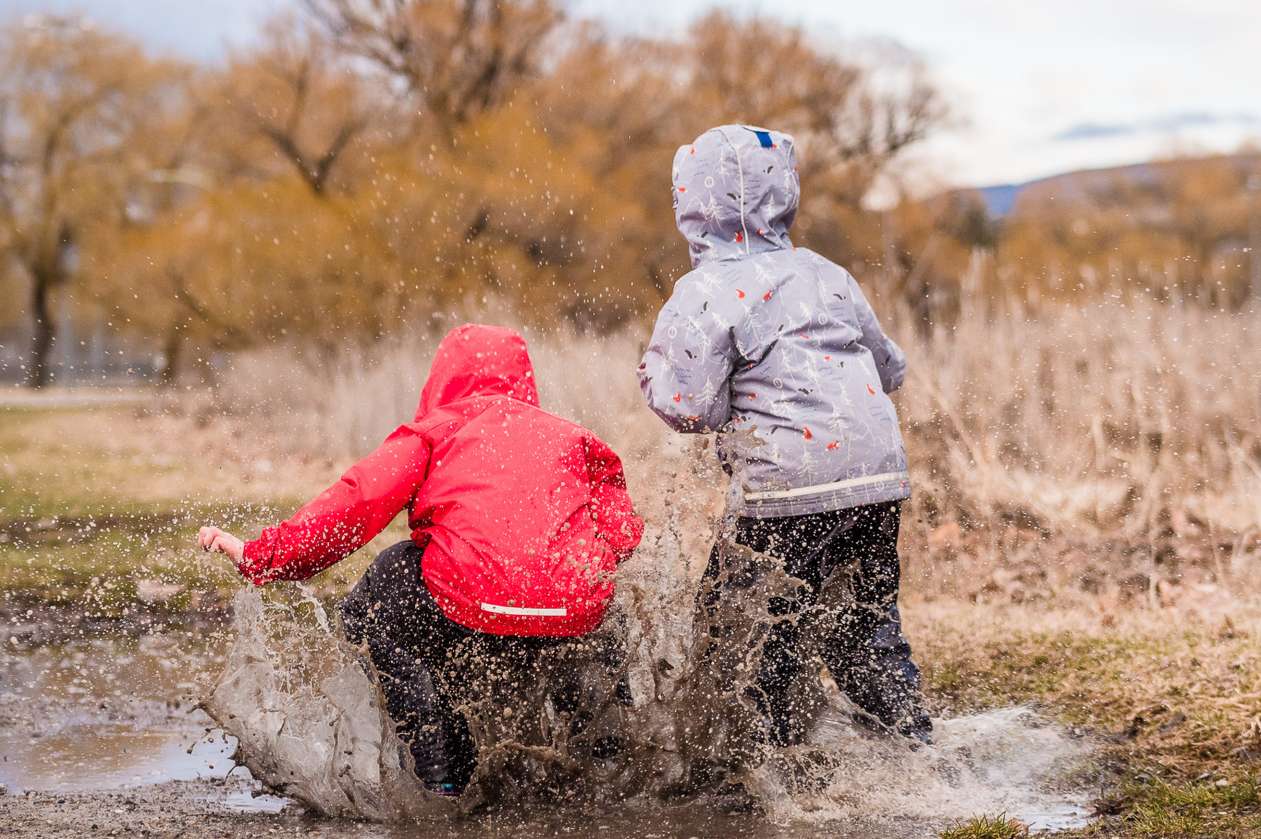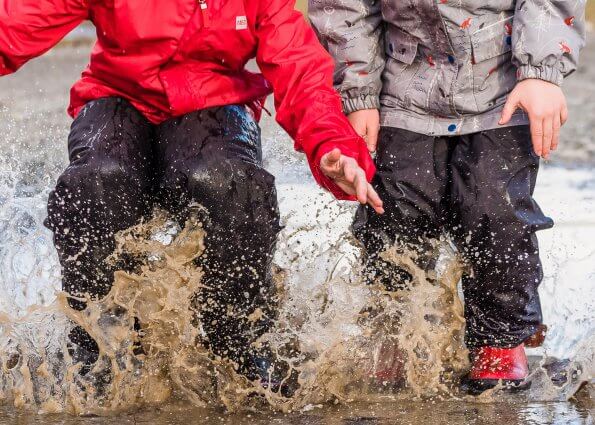
Why puddle play is so great for kids
Puddles have a uniquely magnetic effect on children. I’ve seen it countless times. My children will be happily strolling down a trail and then suddenly they spot a small pool of shimmering water ahead. Immediately their pace quickens and they move forward with clear determination. As they approach a puddle there’s a telltale bounce in their stride. They’re priming their legs for what’s to come: the double foot splash!
When I see what’s about to transpire, I envision piles of wet laundry, sopping boots (or worse yet—shoes!), and a wet child that suddenly realizes they don’t want to be wet. I want to blurt out, “No! STOP!”—but instead, I bite my tongue and wait to see what happens.
You see, a puddle is a magical portal: the moment my children place their feet into that puddle they find themselves in a wonderful wet world filled with new opportunities.
Puddles are such simple things and yet they teach children so much. In many ways, a puddle is like a book, each one unique and filled with new possibilities. Just as books are a gateway into the world of words and stories, puddles provide children with opportunities to learn about movement, the natural world, and play.
A puddle teaches kids how to move their bodies
Learning how to move starts very early on in life. Babies start to experiment with rolling, sitting, and scooting around on all fours. Toddlers and young children learn to walk, run, jump, and more. Learning how to move takes practice. Puddles are a perfect way to practice movement skills.
Puddles are meant to be splashed in. To do that, children need to jump! Jumping develops balance, strength, and agility in little legs and has the benefit of coming in many different styles: big jumps, little hops, run and jump, jumping stars (jacks), arms up or down, jumping with two feet and one-legged hops. Puddles can also be kicked, stirred, and tapped, which are more great movement skills.
To encourage some good puddle jumping, here are some prompts to try out:
- What kind of jump makes the biggest splash?
- Can you jump or kick all the water out of the puddle?
- What happens to a puddle when it’s stirred? (use a foot, hand or stick)
It always helps to be dressed well for puddle play. My children are always more keen to play with puddles longer when they’re wearing rubber boots and pants—or bare feet if the weather’s warm! While a splash in a puddle with shoes is exhilarating at first, kids quickly discover wet shoes aren’t the most comfy things to wear.
A puddle teaches a child about the natural world
Puddles are a science laboratory for kids. Water is such a unique substance on its own, but a small pool of water in nature is an opportunity to learn about evaporation, density, and buoyancy. Here are some simple ideas and questions for introducing puddle science to your child.
- Invite your child to collect a few different bits of nature—a pebble, a leaf, a pinecone, a feather—then bring them to the puddle. Which of the items will sink and which will float? Why?
- Together with your child, outline a puddle on a sidewalk or driveway with chalk. Come back a few hours later and observe the puddle. Did the puddle shrink? Where did the water go? Did it get bigger? Why do you think that happened?
- Find a measuring tape or ruler and help your child measure the puddle. How wide is it? How deep is it? How much water do you think is in this puddle?
- Ask your child to look carefully into the puddle. What do they see? Do they see a reflection? Is there anything living in the puddle?
A puddle invites a child to play!
While we can use puddles to help our children learn about movement and science, there is value in allowing a child to play in a puddle without interruption. Play is a powerful form of learning because children must use their creativity and problem-solving skills without adult help. Often when we see our child’s frustration in play we want to swoop in, but try to wait a few moments before stepping.
Another way to encourage puddle play is to introduce some loose parts such as sticks, rocks, shells, cups, and sieve that would invite your child to interact with a puddle in new ways.
Say “yes!” to being a puddle parent
The next time your child makes a beeline for a wet and wonderful puddle, breathe deep, remember that clothes and children will wash and dry, and say “YES!” to being a puddle parent. I promise you that puddles are positively amazing.
Photos courtesy of Josée Bergeron.








I’d love to have some of your articles available in PDF form. That way, I could print and post in our school, or print and share with families. Thanks for all the great work!
Hi Jessica! Thanks for the comment. Someone will follow up with you shortly!
~Heather
Hi Heather,
I saw your response regarding a PDF about the Value of Puddle Play. Could I get a copy to for my Kindergarten classes?
Hi Rose! Yes! Someone will follow up soon. And please respond here if you don’t hear from anyone by next week.
Can someone recommend a good location in Montreal for puddle play? Like a farm where there is a lot of mud?